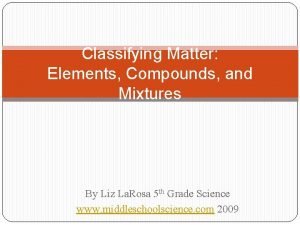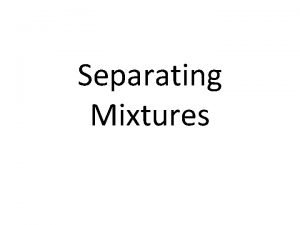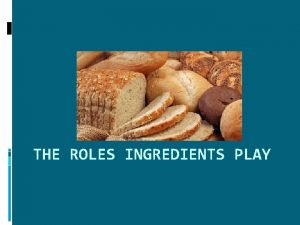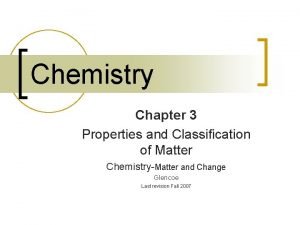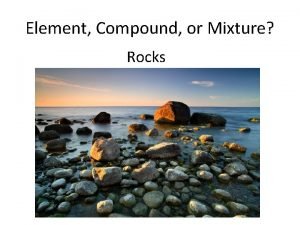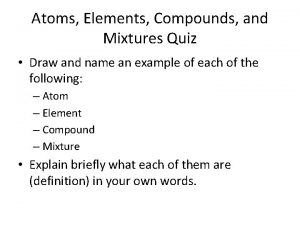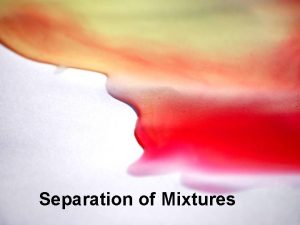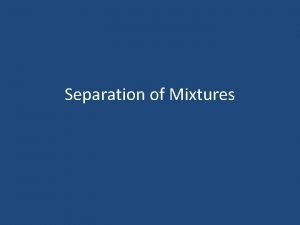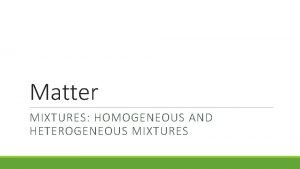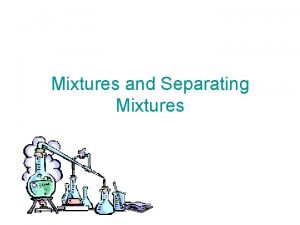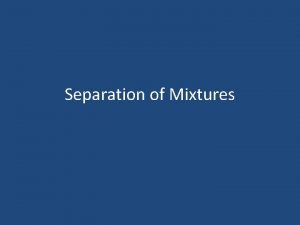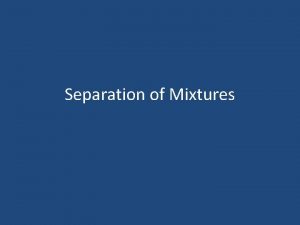Mixtures What is a Mixture Mixture When 2









- Slides: 9

Mixtures

What is a Mixture? Mixture – When 2 or more substances are mixed or “junked” together. The substances are NOT chemically combined in a mixture! A mixture is a physical change. Mixtures can be separated!

Heterogeneous Mixtures Heterogeneous Mixture – A mixture that is unevenly distributed *The parts can be seen and look different! ◦ Examples: Chex Mix, Iced tea, Salad

Homogeneous Mixtures Homogeneous Mixture – A mixture that is evenly distributed. *The parts cannot be seen & look the same! ◦ Examples: Lemonade, Milk, Kool-Aid Also called a Solution!

What is a Solution? Solution: A mixture that forms when one substance dissolves another. Solution = Solute + Solvent Lemonade = Lemon Juice & Sugar + Water

Solvent: A substance that dissolves another substance. Example: Water Solute: The substance being dissolved. The solute is dissolved by the solvent. Examples: Salt, Sugar, Lemon Juice, Alka. Seltzer, Kool-Aid powder

Saturated Solution: A mixture that contains as much dissolved solute as possible at a given temperature. Solutions can reach their Saturation Point, where no more of the solute can be dissolved.

What if a solute does not dissolve in water? Insoluble: When one substance can not dissolve into another substance. Examples: Oil, Sand, Baby Powder

Homogeneous vs. Heterogeneous Complete the Venn Diagram comparing the Homogeneous and Heterogeneous ◦ How are they alike? (2 ways) ◦ How are they different? (2 ways) ◦ Give 3 examples for each type. ◦ Draw one picture for each type.
 Homogeneous mixture and heterogeneous mixture class 9
Homogeneous mixture and heterogeneous mixture class 9 Types of matter elements compounds and mixtures
Types of matter elements compounds and mixtures Magnet in separating mixtures
Magnet in separating mixtures Elements, compounds and mixtures worksheet answer
Elements, compounds and mixtures worksheet answer Examples of flour mixtures
Examples of flour mixtures Lightweight concrete mix ratio
Lightweight concrete mix ratio Common homogeneous mixtures
Common homogeneous mixtures Mixtures and solutions quiz
Mixtures and solutions quiz Is a rock a element compound or mixture
Is a rock a element compound or mixture Elements compounds and mixtures quiz
Elements compounds and mixtures quiz

